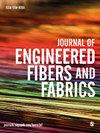A sustainable approach for linen dyeing and finishing with natural lac dye through chitosan bio-mordanting and microwave heating
IF 2.3
4区 工程技术
Q1 MATERIALS SCIENCE, TEXTILES
引用次数: 2
Abstract
Sustainability has become a global requirement in all industries. In the textile sector sustainability can be achieved by developing innovative techniques, approaches, and machinery. The current study introduces a sustainable approach for linen dyeing with natural lac dye using microwave heating after the treatment with chitosan as a cationic bio-mordant. The chitosan treatment was carried out by a pad/dry-cure process with citric or acetic acid. Linen samples were characterized by scanning electron microscopy (SEM), and fourier transform infrared spectroscopy (FTIR). The results confirmed the deposition of chitosan on linen fabric with both citric and acetic acid. X-ray diffraction (XRD) was used to determine the change in the crystallinity of linen fabric after chitosan treatment and lac dyeing. The color strength results confirmed the successful application of chitosan as a bio-mordant and the efficiency of microwave heating in shortage the dyeing period in lac dyeing, where the K/S increased from 1.54 to reach 18.86 and 13 with acetic and citric acid, respectively in 7 min. Furthermore, the maximum color strength was achieved at pH 3 of lac dye and the presence of chitosan eliminated the usage of salt in the lac dyeing of linen fabrics. Fastness properties of the lac dyed linen fabrics to wash, light, and perspiration have been discussed. The functional properties (antibacterial activity and UV protection) of linen fabrics were assessed. The antibacterial activity was decreased after the chitosan-treated linen samples were dyed with lac dye. However, the UPF of linen samples was enhanced after lac dyeing.壳聚糖生物媒染-微波加热-天然紫胶染料对亚麻织物的可持续染色整理
可持续发展已成为所有行业的全球要求。在纺织行业,可持续性可以通过开发创新技术、方法和机械来实现。介绍了一种以壳聚糖为阳离子生物媒染剂,对天然紫胶染料进行微波加热的亚麻可持续染色方法。用柠檬酸或乙酸对壳聚糖进行垫/干固化处理。采用扫描电镜(SEM)和傅里叶变换红外光谱(FTIR)对亚麻样品进行了表征。结果证实了柠檬酸和乙酸对壳聚糖在亚麻织物上的沉积作用。用x射线衍射(XRD)测定了壳聚糖处理和紫胶染色后亚麻织物结晶度的变化。色度结果证实了壳聚糖作为生物媒介剂在紫胶染色中的成功应用以及微波加热在短时间染色中的效果,在7 min内,用乙酸和柠檬酸对紫胶染色的K/S分别从1.54提高到18.86和13。此外,紫胶染料在pH为3时达到最大色强,壳聚糖的存在消除了亚麻织物紫胶染色中盐的使用。讨论了紫胶染色亚麻织物的耐洗、耐光、耐汗牢度。对亚麻织物的抗菌性能和防紫外线性能进行了评价。经壳聚糖处理的亚麻经紫胶染色后,其抑菌活性下降。而亚麻样品经紫胶染色后,UPF有所提高。
本文章由计算机程序翻译,如有差异,请以英文原文为准。
求助全文
约1分钟内获得全文
求助全文
来源期刊

Journal of Engineered Fibers and Fabrics
工程技术-材料科学:纺织
CiteScore
5.00
自引率
6.90%
发文量
41
审稿时长
4 months
期刊介绍:
Journal of Engineered Fibers and Fabrics is a peer-reviewed, open access journal which aims to facilitate the rapid and wide dissemination of research in the engineering of textiles, clothing and fiber based structures.
 求助内容:
求助内容: 应助结果提醒方式:
应助结果提醒方式:


